The Corsair Hydro X Custom Water Cooling Review, on a Ryzen 9 3950X
by Gavin Bonshor on February 5, 2020 9:00 AM ESTCorsair Hydro X Build Experience
We used the Corsair Hydro X set to best effect in our testing of the ASRock X570 Aqua. To complement the review, we decided to do a full system build featuring ASRock's AMD RX 5700 XT Taichi 8 GB graphics card and other hardware which Corsair provided. Everything bar the motherboard and the AMD Ryzen 3950X processor for this build was provided by Corsair. The full system specifications and test setup are located on the next page, although the full performance of power delivery thermals combined with Corsair's Hydro X parts can be found in our ASRock X570 Aqua review. As the ASRock X570 Aqua comes fitted with its own custom water block which cools the CPU, the power delivery on the motherboard, and the chipset, we didn't use any of Corsair's water blocks for this system.
The Corsair Hydro X Aqua System: All the AMD
Since we aren't using any of Corsair's CPU or GPU blocks for this system, all of the focus is on the core components themselves including the XD5 pump and reservoir combination, a single XR7 240 mm radiator, as well as Corsair's LL120 RGB 120 mm cooling fans and it's Softline range. We did intend to use an additional 360 mm cooling radiator, but the Corsair Crystal 680X with our hardware wasn't compatible due to the ASRock X570 Aqua's larger than normal E-ATX size.
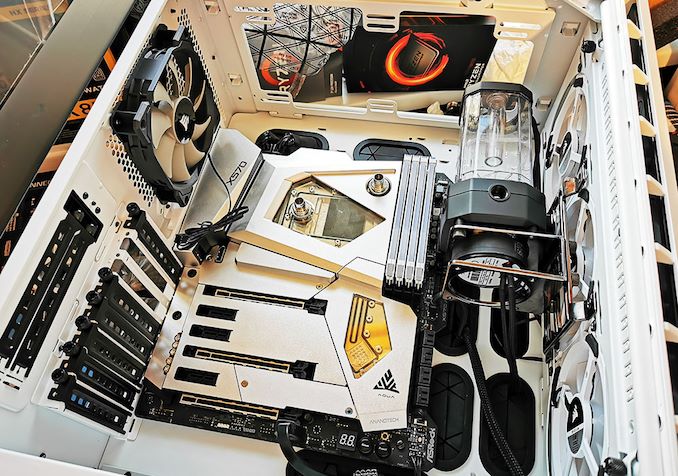
Testing possible hardware configurations inside the Corsair Crystal 680X
The first task before even unboxing the hardware was to work out which way it was going to be configured and routed around the Corsair Crystal 680X chassis. As our motherboard is E-ATX and this is technically for ATX motherboards, we did experience a couple of headaches. This wasn't to the detriment of Corsair, but more our hardware was just too big to fit in. As a result, we decided to go with a single 240 mm radiator to cool the CPU, power delivery, and chipset which the ASRock X570 Aqua block covers.
The Corsair Hydro X Series XD5 comes with mounting brackets to allow installation into various parts of a system. We decided to opt for the safer option and mount it to one of the 120 mm intake fans on the front. This was primarily to allow us to show off the XD5 in the front of the chassis, instead of mounting it in the rear chamber. The XD5 itself looks good with its nylon clear chamber, and the mounting kit is solid and sturdy.
Due to space constraints, we mounted a 240 mm radiator in a pull configuration which intakes air from the bottom of the chassis. We are using three Corsair LL120 RGB 120 mm fans in the front, with two on the radiator, and one in the rear as an exhaust. Each fan is connected to the Corsair Commander Pro controller which allows us to control everything from the Corsair iCUE software.
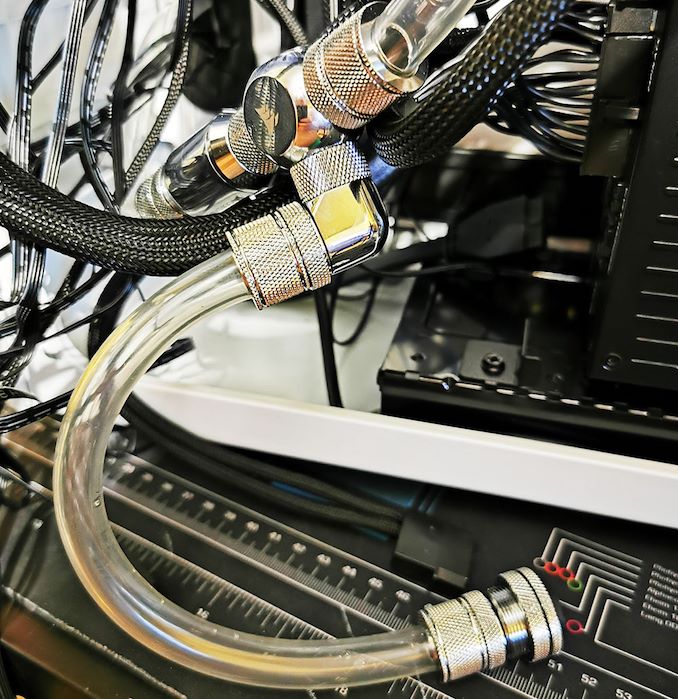
Drain port installation, should the worst happen
For better aesthetics, we routed one of the tubes through the rear chamber of the chassis, but this also allowed us to create less obstruction in the main chamber without needing to run tubing everywhere across components. For easy draining, we connected a ball valve which we can close for draining, and installed a drain port with plenty of tubing to drain without needing to dismantle the loop. This sits in the rear chamber at the bottom and is tucked away in front of the Corsair HX850 850 watt 80PLUS Platinum power supply.
After hours of countless routing and optimization of the tubing and layout, our system was complete. One thing about the Corsair Hydro X series is that it looks good, and is user-friendly making custom loop water cooling more accessible to consumers than ever before. What makes it more accessible is Corsair's Custom Cooling Configurator allows users to put in their hardware into the configurator and allow Corsair to work out what water cooling components are needed for whatever array of components are being used, or plan to be used. The Corsair Cooling Configurator is easy to use, intuitive and looks modern. This is something Corsair has put many months into designing for the end-user to make its buying decisions easy.
With the addition of the Corsair Commander RGB hub, we could connect all of the Corsair Hydro X series components including the fans and XD5 pump and reservoir combo up and sync everything up to the Corsair iCUE software; this includes the Corsair Vengeance Pro RGB memory. At present only ASUS hardware is certified to be used with Corsair iCUE in an exclusive partnership we learned about during CES 2020. As we are using ASRock hardware, we had to sync them up individually, but we like the contrasting look and having the ability to add effects.


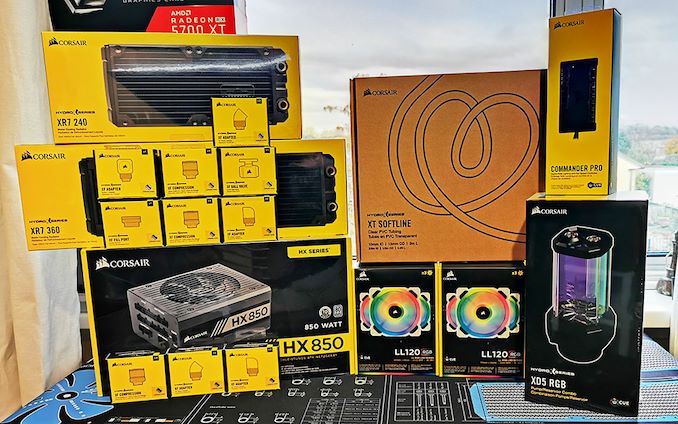

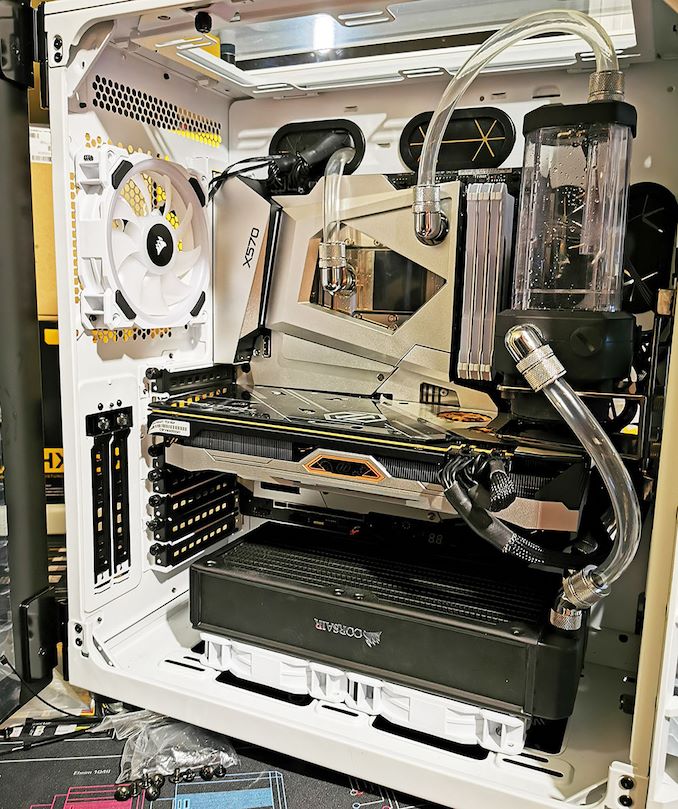
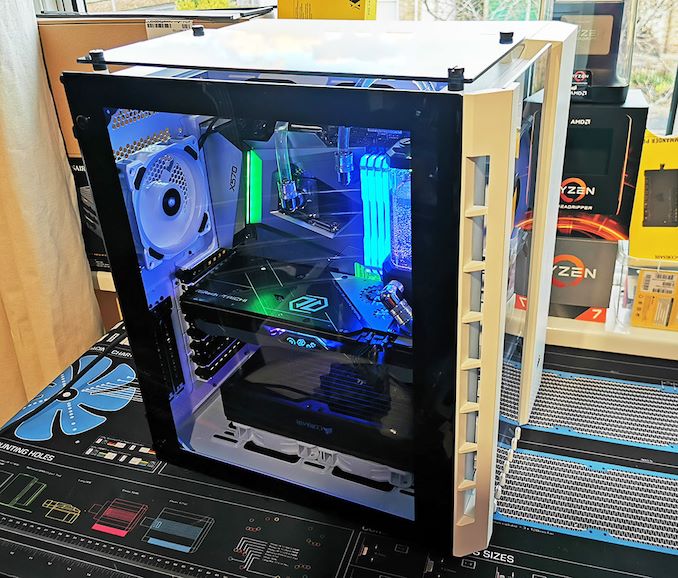
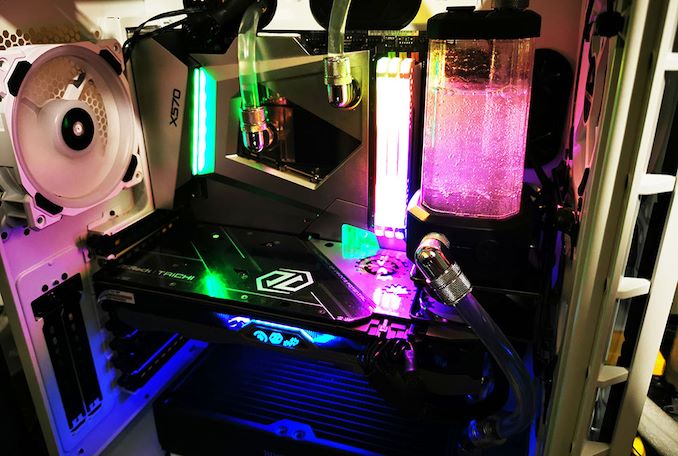








72 Comments
View All Comments
airdrifting - Wednesday, February 5, 2020 - link
"The cooling performance was also astronomical (can't break 52 C under max load on GPU w/overclock)"?Shill detected. I have never been able to break 52 C under load with ANY custom liquid cooling on a flagship GPU, that includes all titans and flagships from 780 Ti to 2080 Ti, the highest I get is like 47C. Even with the EVGA Hybrid cards with AIO liquid cooling and 120mm radiator, you will never see 55C in most cases.
The cooling performance in a custom liquid cooling loop is not just about the radiator, the fans, pump, block, the shape of the loop all matters. Using a mediocre load temperature to claim the radiator is good is absurd, and I have seen anyone talking about "screw/tube protectors" on a radiator, wtf is that? If you are talking about the little metal shield underneath the screw hole but above the fins, that is completely useless because you can simply have the screw holes spaced between the fins instead of the tiny tubes like every single radiator is doing nowadays. Even if the screws are too long they will just bend the fins which doesn't really matter as long as they don't pierce the tube.
brontes - Wednesday, February 5, 2020 - link
Wait, how is he a shill if you're the one getting better performance?Anyway, Corsair rebadges hardwarelabs rads. They swap out to thicker screw channels to reduce the chance of puncture in case you for some reason have a three year old with power tools doing the installation sideways, and they include longer screws for push+pull in the box. And they put their logo on it. Other than that, it is a HWL product.
AshlayW - Thursday, February 6, 2020 - link
How is he a shill if he's not putting the product in the best possible light? Shut up.PeachNCream - Wednesday, February 5, 2020 - link
$500+ in order to run an overclock that may work on a cheaper cooler or even on air cooling that ultimately gains 5% in a couple of benchmarks. Yes, it looks cool. Yes, you can say you put together a custom cooling loop. That's a lot of effort, resources, and time for little reward over not overclocked parts running an inexpensive air cooler.airdrifting - Wednesday, February 5, 2020 - link
Try 2%. With turbo boost and Intel falling behind in nm technology, there is very little OC headroom for processors like 9900K which is already pushed to the limit at 4.7GHz all core. AMD's PB does a better job than manual OC most of the time. Video cards are wattage capped so it's not like raising the voltage or core frequency does much, MSI AB doesn't work on most of the cards when it comes to raising TDP.LedHed - Wednesday, February 5, 2020 - link
Many cards can have their power limit raised to 108% of the stock rating using Afterburner. However, like you said, there are cards that won't allow you to raise that limit at all. There are also cards that allow you to raise the limit up to 112%, so it goes both ways.I do agree that using dedicated H2O setups on current generation cards will be disappointed by their OC gains. This is due to how tight the power constraints were on the last 2 or 3 generations of NV cards. Well, unless you are willing to take a soldering iron to their GPU, then all bets are off! Voltage mods are a lot of fun, as long as you don't kill the card!
liquid_c - Wednesday, February 5, 2020 - link
I can guarantee you that almost all of the 9900k on the market can reach an all-core 5ghz OC, even those from lots sold after the launch of the 9900ks. You do need a *solid* cpu cooler and if you live in a place with high ambient temps then you’re facing an uphill battle.My own personal recommendation would be to use at least a 280mm AIO for the CPU alone, in this use case (Kraken X62, H115i, etc.), with these beefy CPUs.
airdrifting - Thursday, February 6, 2020 - link
Only when you use a 360mm or better liquid cooling. I have handled many 9900K, single 120mm rad is not enough to keep most under load without overclocking, you will see instant 90C+. 240mm rad is probably the minimal for 9900K unless you want to undervoltage. It's just not worth it to get a 0.3GHz OC for so much hassle. On the contrary, H60 can easily keep 3700X under 65C.brontes - Wednesday, February 5, 2020 - link
Its not about OC these days, it about RGB/bling or silence. And I've discovered for a vast majority of the bling people, its not a "set it and forget it" deal, but much closer to a hobby. They're constantly tinkering and rearranging and replacing with the latest unicorn vomit fans and such. "Old" cooling parts build up and then its a challenge to watercool some old system with an "unfriendly" case they had sitting around that doesn't even actually get use. And so on. Hey, its their money and they're having fun, so whatever. And because they spend lots of money on tons of various parts, you can get good advice from from people with lots of first hand experience with different products very easily.I'm one of the uncommon ones that just wants it to work, without lights.
Its honestly a little creepy at first. After 30 years of the computer responding to heavy loads (esp. on the gpu) with *some* sort of noise its just.. not there anymore.
It is certainly a hell of a lot cheaper if noise doesn't bother you and you stick to air. But alas, the initial outlay is done. That aside, maintenance is easier/less frequent than I expected with some silly tricks as well as not using colored fluid. I'm looking at +$200 on each socket+gpu swap for blocks, which isn't terrible considering a good CPU HSF or AIO is $80-150, and there isn't even a comparable option for the GPU or chipset unless you get "creative."
But yeah, "home overclocking" is pretty much dead and any extra additional headroom from watercooling is considered a tertiary fringe benefit.
FatBoyDiesel - Wednesday, February 5, 2020 - link
Not gonna lie, I went full RGB so I could set the color scheme to the colors of the Ryzen Halo logo. It worked best in a case like the Thermaltake Core V1, I replaced the stock 200mm fan for a faster 200mm Riing Plus RGB fan and got the effect to work nicely.Then I upgraded to the Nouvolo Steck. I got a 240mm H100i v2 for it and appreciated the extra RGB (RAM, motherboard, AIO). However, I didn't like the extra cost and didn't need the extra RGB per se. I went for a custom loop, with the fans being the first to be replaced with regular fans. My blocks are RGB, sure, with the XC7 requiring the Lighting Node Pro. That thing was what I wanted with 4 RGB strips with a tiny RGB controller to fit in a small space for such a compact build. I honestly thought about simply abandoning most RGB components in the future save RAM and my Lightning Node Pro. The cost of RGB on everything is so dumb to me. I also don't like unicorn vomit.